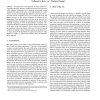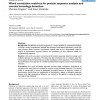17 search results - page 2 / 4 » Algorithm For Automatic Interpretation Of Noun Sequences |
GECCO
2003
Springer
13 years 10 months ago
2003
Springer
The process of labeling each word in a sentence with one of its lexical categories (noun, verb, etc) is called tagging and is a key step in parsing and many other language processi...
ECAI
2000
Springer
13 years 9 months ago
2000
Springer
Abstract. We propose here a new approach for video sequence interpretation based on declarative models of activities. The aim of the video sequence interpretation is to recognize i...
IVC
2006
13 years 5 months ago
2006
A motion detection and tracking algorithm for human and car activity surveillance is presented and evaluated by using the Pets'2000 test sequence. Proposed approach uses a te...
BMCBI
2008
13 years 5 months ago
2008
Background: Classification of protein sequences is a central problem in computational biology. Currently, among computational methods discriminative kernel-based approaches provid...
CSL
2002
Springer
13 years 5 months ago
2002
Springer
A spoken language generation system has been developed that learns to describe objects in computer-generated visual scenes. The system is trained by a `show-and-tell' procedu...


